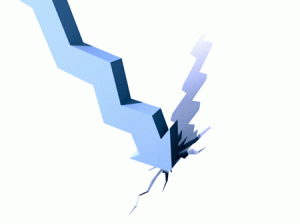It is up to 60 billion dollars of foreign capital Russia has lost since August. Russia’s hard currency and gold reserves have slipped for the last 6 weeks down 65 billion. A further meltdown of its currency reserves could have a negative effect on Russia’s credit rating (which currently stands at BBB+). Russian companies and banks which are heavily indebted to western banks – total sovereign corporate debt is about 480 Bln. USD – suffer from a serious liquidity crunch. In the 4th quarter of 2008 only, Russian companies will have to pay back or refinance a combined debt of 47 Bln. USD to foreign creditors.
Russia’s macroeconomic balance sheet is turning blue. Russia’s current account will break even in early 2009, her trade balance will touch zero in 2010. With prices for Russia’s Urals blend currently down at 65 USD per barrel Russia’s budget will turn negative for the first time since 2000. (the current budget will be balanced only with average oil prices at 70 USD per barell). In 2008 Russia still commanded a budget surplus of 8.2 per cent of GDP. What is more, if oil prices going down to 55- USD, the Russian Central bank will be hard pressed to let the ruble devaluate.
The significant drop in crude oil prices – down from 142.5 Bln. USD in July to 66 USD per barrel of Ural’s Blend this week – triggers a dangerous downward spiral. Russia’s state oil company Rosneft is hugely indebted. With capital supplies drying up Rosneft needs state financial support. Like all big Russian oil companies, Rosneft is currently facing a crisis and will lack sufficient funds for the exploration of new oil fields. On October 14th, the Russian government passed a bailout deal for Rosneft (4.2) LukOil (2.0), TNK-BP (1.8) and Gazprom (1.0) worth 9 Bln. USD.
Russia’s oil production, however, is already stagnating. With new investment shortened or delayed, oil production will decline, for the first time since many years. The Russian government has started aiding the ailing oil industry by lowering taxes and export tariffs. As a consequence, budget revenues from the oil sector is declining. Given the fact that the Russian oil and gas sectors generate about 34 per cent of Russia’s budget this will have a major impact on the budgetary balance. Russia’s ambitious plan to boost infrastructure investment, modernising health care, education and the pension system, mentioned in ist long-term modernisation agenda till 2020, will fall victim to a lack of budgetary means.
Russia thus faces a bleak future. Falling oil prices and declining production cut in state revenues. The huge indebtedness of oil companies demand tax cuts for the oil industry thus further decreasing state revenue. Both trends will turn the budget negative, the trade balance down. In addition, falling oil prices will push Russia to lower gas export prices as well, as long-term contracts with EU gas consumers link gas prices to a fuel basket with a time lag of between 3 and 6 months. Russia’s economic miracle takes on some nasty stains.
Picture taken from:
http://blog.izilogipro.com/crise-de-limmobilier-la-fnaim-voit-enfin-venir-le-mur.html


Interesting read, Gerhard! How would this slippery slope affect Russia’s ability to modernize its strategic forces? Do you expect a return to the conditions of the 1990s? Bleak future for Topol-M as well?
Looking forward to your reply,
Martin
As of today, I do not think that defense procurement will be affected negatively. Only a couple of days ago, in the midst of the serious financial crisis, President Medvedev summoned deputy head of government Sergei Ivanov (a former Russian defense minister) and explicitly ordered him in public to stick to the previously agreed on defense procurement order of 49.5 Bln. USD in 2009. In addition, Medvedev insisted on the implementation to the long term (2015) procurement programme. I do expect, however, that the government will also abide by the programme’s previously agreed in moderate shift to increase the funding of Russia’s conventional forces.
The New York Times has an interesting article on the issue:
“Russia Is Striving to Modernize Its Military” by Shanker.
http://www.nytimes.com/2008/10/20/world/europe/20military.html?_r=1&ref=europe&oref=slogin
Für Rüstungsmaßnahmen wird immer noch genug an Geld aufzutreiben sein. Vor allem, wenn man sich von der NATO zunehmend “eingekreist” und von oben her beobachtet fühlt. Die Produkte der Rüstungsindustrie lassen sich zudem – erwiesenermaßen – gegen gute Devisen vortrefflich in alle Welt exportieren. Das Rüstungsgeschäft ist immer konjunkturunabhängig und trotzt jeder Rezession. Auch der gegenwärtig weltweiten …